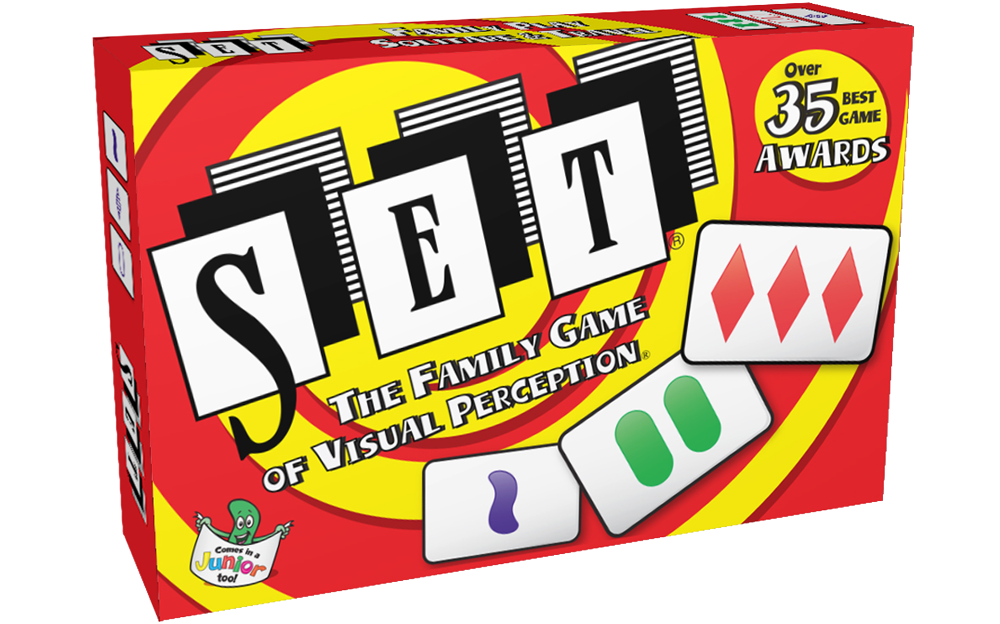SET
Players: 2 or more
Ages: 5 and up
Purchase: Buy on Amazon (affiliate link)
Math Ideas: Classification, pattern recognition, justification
Questions to Ask:
What about these three cards is alike? What is different?
What card would complete the set with these two cards?
SET is a family favorite for me because it is equally challenging for young kids, teenagers, and adults. Also, any amount of people can play, and folks can walk by and join the game whenever they like. It's perfect for a big family gathering as well as a fun one-on-one conversation with your child.
How to Play
To play SET, you simply deal out 12 cards, face-up, on a table. The goal of the game is to identify a set of three cards that are connected by their attributes.
The cards in Set have four attributes that players use to look for sets.
-Color (either red, purple, or green)
-Number (one, two or three shapes)
-Shape (diamonds, ovals, or squiggles)
-Shading (solid, striped, or empty)
At left is an example of a set, which is a group of three cards that either share the same attribute (all three cards are squiggly) or all differ in one attribute (each card has a different color). A good rule of thumb is that if a group of three cards has any attribute that only two cards share, it’s not a set.
If you'd like to give it a try, the makers of SET have a free daily puzzle on their website. Give it a try!
Traditionally, the cards are placed on a table and anyone who see a set can yell out "Set!" and collect their cards. I prefer a less competitive version where people take turns finding sets, as it gives younger kids more time to think and leaves room for more conversation along the way.
For younger players, it’s probably best to start with the 27 solid cards. As your kids get more and more comfortable finding sets, you can add the striped and empty cards to raise the level of sophistication.
Where's the Math?
This game helps kids build their ability to classify objects. This may not seem like a math skill at first, but in fact it is deeply connected to mathematical thinking. Every time your child is asked to find several objects that all share something in common, they are noticing patterns between objects.
Later in school, they will be asked to look for patterns within numbers.
Which of these numbers is divisible by 2?
125 48 2463 50 12
In order to answer this question, we need to look at a specific attribute of each number: specifically, whether the ones digit is even or odd. Kids need lots of experience looking at a group of objects and paying attention to one or two attributes while ignoring others.
SET also provides a lot of opportunities for justification, debate, and logical thinking. Inevitably, one person will pick three cards that do not form a set. It is everyone else’s job to find their error and convince them that they made a mistake. That mental leap, from identifying an error in logic to explaining that error, is a big developmental step for kids at any age.
Questions to Ask
Recently, I played SET with my son J and his cousin H. Each time they found a set, I asked them to explain how they knew it was a set, as you can see below.
As you can see, I let J and H do their own justifying and correcting each other. I didn't want to be the game's referee, since they were just as capable of identifying sets as I was.
Sometimes, J and H would get stuck, which happens a lot as kids learn this game. To help get them unstuck, I would point out two cards that started a set and ask them to find the third card. If the first two cards were both ovals, J and H knew they were looking for a third card with ovals. If the first two cards were red and purple, the kids knew to search for a green card. This really helped keep them invested in the game.
A harder extension of this idea is to draw two cards at random from the deck and ask your child “what would the third card in this set look like?” The good news is, for every two cards there is a third card that completes the set. The bad news is, it’s hard to describe! Give it a shot yourself: what card completes the set at left?
For very young kids, it can be challenging but fun simply to find a card based on a description. I’ve played a variation of the game with my 2 1/2 year old daughter H where I ask her to find the card with two green ovals. Paying attention to three different attributes of the card at the same time is quite a mental challenge, but she absolutely loves it.
As with many of my favorite games, the SET cards provide a canvas for mathematical play that you can adapt to the needs and interests of your particular kid. I highly recommend this game.
Buy SET on Amazon (affiliate link)




